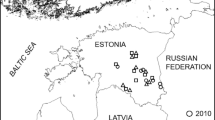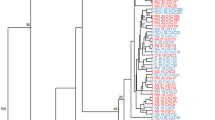Abstract
Ninety-five isolates ofPhytophthora infestans collected throughout Poland during 1985–1991 and characterized for multilocus genotypes based on mating type, allozymes and DNA fingerprint, were analyzed for specific virulence to differential potato cultivars carrying ten major resistance genes. The multilocus analysis led to three groupings. The first group contained 22 isolates of a clonal lineage (PO-1) that is postulated to have been present in Europe during most of the twentieth century, but PO-1 isolates were recovered in Poland only during 1985–1988. This group contained, on average, virulence to 5.5 specific resistance genes per isolate. The second group consisted of 30 isolates in a clonal lineage (PO-4) that had not been detected before 1988. PO-4 isolates had virulence to a mean of 6.5 resistance genes per isolate. The third group was composed of 43 isolates representing 38 multilocus genotypes also not detected before 1988. These diverse genotypes had virulence to an average of 6.7 specific resistance genes per isolate. More than half (53%) of the PO-4 isolates shared a single pathotype. The group of 43 isolates was dominated by two pathotypes: the most common one (47% of the isolates) was the same pathotype that dominated PO-4 isolates; the next most common one (21%) differed from the most common one by the absence of virulence to resistance gene R5. The recent immigrant isolates (not detected before 1988) generally had virulence to a greater number of specific resistance genes than did isolates in the previous population [detected before 1988 (PO-1)]. Recent immigrant populations were dominated by one or two pathotypes, so their pathotypic diversity values were somewhat less than that of the previous population.
Similar content being viewed by others
References
Andrivon D (1994) Race structure and dynamics in populations ofPhytophthora infestans. Can J Bot 72: 1681–1687
Caten CE and Jinks JL (1968) Spontaneous variability of single isolates ofPhytophthora infestans. I. Cultural variation. Can J Bot 46: 329–348
Drenth A, Tas ICQ and Govers F (1994) DNA fingerprinting uncovers a new sexually reproducing population ofPhytophthora infestans in the Netherlands. European J. Plant Pathol 100: 97–107
Fry WE, Goodwin SB, Dyer AT, Matuszak JM, Drenth A, Tooley PW, Sujkowski LS, Koh YJ, Cohen BA, Spielman LJ, Deahl KL, Inglis DA and Sandlan KP (1993) Historical and recent migrations ofPhytophthora infestans: chronology, pathways, and implications. Plant Dis 77: 653–661
Goodwin SB, Cohen BA, Deahl KL and Fry WE (1994a) Migration from northern Mexico as the probable cause of recent genetic changes in populations ofPhytophthora infestans in the United States and Canada. Phytopathology 84: 553–558
Goodwin SB, Cohen BA and Fry WE (1994b) Panglobal distribution of a single clonal lineage of the Irish potato famine fungus. Proc Nat Acad Sci USA 91: 11591–11595
Goodwin SB, Saghai Maroof MA, Allard RW and Webster RK (1993) Isozyme variation within and among populations ofRhynchosporium secalis in Europe, Australia and the United States. Mycol Res 97: 49–58
Goodwin SB, Sujkowski LS, Dyer AT, Fry BA and Fry WE (1995a) Direct detection of gene flow and probable sexual reproduction ofPhytophthora infestans in northern North America. Phytopathology 85: 473–479
Goodwin SB, Sujkowski LS, and Fry WE (1995b) Rapid evolution of pathogenicity within clonal lineages of the potato late blight disease fungus. Phytopathology 85: 669–676
Hohl HR and Iselin K (1984) Strains ofPhytophthora infestans from Switzerland with A2 mating type behavior. Trans Br Mycol Soc 83: 529–530
Koh YJ, Goodwin SB, Dyer AT, Cohen BA, Ogoshi A, Sato N and Fry WE (1994) Migrations and displacements ofPhytophthora infestans populations in east Asian countries. Phytopathology 84: 922–927
McDermott JM and McDonald BA (1993) Gene flow in plant pathosystems. Annu Rev Phytopathol 31: 353–373
McDonald BA and McDermott JM (1993) Population genetics of plant pathogenic fungi. BioScience 43: 311–319
Pietkiewicz JB (1978) Pathogenic variation among field isolates ofPhytophthora infestans. Phytopathol Z 93: 289–294
Rivera-Peña A (1990) Wild tuber — bearing species ofSolanum and incidence ofPhytophthora infestans (Mont.) de Bary on the western slopes of the volcano de Toluca. 3. Physiological races ofPhytophthora infestans. Potato Res 33: 349–355
Schick R and Klinkowski M (1962) Die Kartoffel. VEB Deutscher Landwirtschaftsverlag, Berlin
Sheldon AL (1969) Equitability indices: dependence on the species count. Ecology 50: 466–467
Sieczka TM (1979) Proba optymalizacji warunkow selekcji ziemniakow pod katem widzenia odpornosci polowej naPhytophthora infestans (Mont.) de Bary. PhD Thesis, Potato Research Institute, Bonin, Poland
Spielman LJ, Drenth A, Davidse LC, Sujkowski LJ, Gu WK, Tooley PW and Fry WE (1991) A second world-wide migration and population displacement ofPhytophthora infestans? Plant Pathol 40: 422–430
Sujkowski LS (1992) Zmiennosc wirulencji i agresywnosci u grzybaPhytophthora infestans (Mont.) de Bary w stosunku do ziemniaka (Changes in virulence and aggressiveness inPhytophthora infestans (Mont). de Bary with respect to the potato). Habilitation Thesis, Potato Research Institute, Mlochow, Poland
Sujkowski LS, Goodwin SB, Dyer AT and Fry WE (1994) Increased genotypic diversity via migration and possible occurrence of sexual reproduction ofPhytophthora infestans in Poland. Phytopathology 84: 201–207
Swiezynski KM, Krusiec J, Osiecka M, Sieczka TM and Zarzycka H (1993) Potato tuber resistance toPhytophthora infestans and its relation to maturity. Plant Breeding 110: 161–164
Swiezynski KM, Sieczka TM, Sujkowski LS, Zarzycka H and Guzowska-Zimnoch E (1991) Resistance toPhytophthora infestans in potato genotypes originating from wild potato species. Plant Breeding 107: 28–38
Tooley PW, Sweigard JA and Fry WE (1986) Fitness and virulence ofPhytophthora infestans isolates from sexual and asexual populations. Phytopathology 76: 1209–1212
Author information
Authors and Affiliations
Rights and permissions
About this article
Cite this article
Sujkowski, L.S., Goodwin, S.B. & Fry, W.E. Changes in specific virulence in Polish populations ofPhytophthora infestans: 1985–1991. Eur J Plant Pathol 102, 555–561 (1996). https://doi.org/10.1007/BF01877022
Accepted:
Issue Date:
DOI: https://doi.org/10.1007/BF01877022




